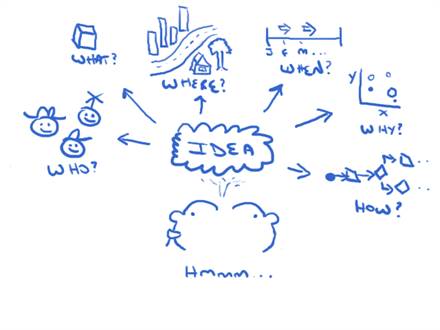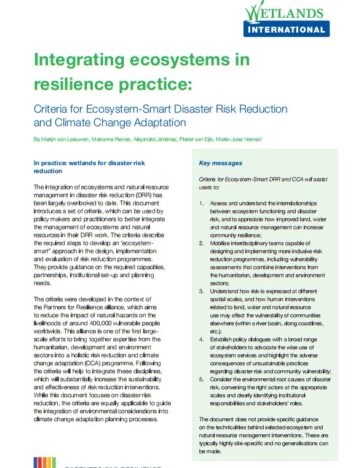
10 tips to become ecosystem smart in Disaster Risk Reduction interventions
-
Climate and disaster risks
-
Coastal resilience
-
Community resilience
-
Integrated delta management
10 tips developed by Wetlands International for policy makers and practitioners to better integrate the management of ecosystems and natural resources in their Disaster Risk Reduction (DRR) work.
1. Build understanding and capacity on ecosystems and the services they deliver
Build capacity of government at all levels, communities and civil society organisations on the services that ecosystems deliver and how these benefit people including for agriculture, forestry, fisheries, water and sanitation, health and safety. Ensure their knowledge is enhanced on what the root causes are of ecosystem degradation and their current and projected condition. These stakeholders and implementing organisations should be aware of how ecosystems are connected across landscapes and what the implications are of ecosystem degradation for disaster risk at the landscape and community levels. Provide examples of spatial dimensions, such as upstream-downstream linkages, and connections along coastlines.
2. Undertake risk and vulnerability assessments at the appropriate levels
Capture regional dimensions and root causes of risk and vulnerability through landscape or catchment level assessments. Understand how human interventions related to land, water and natural resource use may affect the vulnerability of communities elsewhere (within a river basin, along a coastline etc.). Judge whether DRR-specific, environmental, land use and development policies are ecosystem-smart or may have implications for disaster risk. Integrate community-level vulnerability assessments with landscape risk assessments.
3. Design multidisciplinary DRR project teams
Include people with different disciplines in the DRR team, including experts from humanitarian, development and environment fields, along with other relevant disciplines (economics, land use planning, hydrology, engineering, etc.). These experts act as full members of the project team (incl. participation in field trips, assessments and meetings) in all phases.
4. Involve relevant stakeholders in the integrated risk reduction programme
Identify relevant stakeholders in land use and development planning at the local, provincial and national levels and develop partnerships for their full involvement in the development and implementation of risk reduction programmes. Consider involving policymakers, government agencies, CSOs, knowledge institutes, the private sector (including investors), river basin authorities, coastal managers, other stakeholders in land and water use and development at the local, provincial and national levels, and communities.
5. Include ecosystem services in cost-benefit analyses
Ensure that risk reduction scenarios are identified based on analysis that include quantifying the values of gained or lost ecosystem services. Consider effectiveness, priority setting and sustainability.
6. Include ecosystem-based approaches in Risk Reduction Plans
Identify how to address environmental root causes of risk and opportunities for improved ecosystem management at the household and the landscape level. This typically involves multiple intervention strategies, both for short-term disaster preparedness and longer-term disaster impact reduction, involving policy dialogue, community-based measures, awareness raising etc. The most effective strategy might require addressing root causes and broadening the geographical scope of the programme. If sustainably managed, ecosystems can act as buffers against hazards. For example, restored mangrove belts can protect coasts against high waves and storm surges. Well-functioning floodplains can reduce floods downstream. Hill reforestation, agro forestry and terrace agriculture can be effective DRR interventions to prevent landslides as well as ensure the provision of water resources downstream.
7. Create an enabling public and private policy environment for ecosystem-smart DRR
Review policies and plans on DRR and identify if these are ecosystem-smart. Mainstream ecosystem service considerations into government and corporate policies and sustainable development plans. Tools include the requirement of Environmental Impact Assessments or environmental safeguards in land use and development policies. In this way you can prevent that DRR interventions negatively impact vital ecosystem services and biodiversity, such as ill-informed sectoral developments and investments. Re-orientate investments and measures to combine increased ecosystem resilience and DRR.
8. Collaborate with other DRR and development initiatives in the region
This improves outreach and impact. Avoid unintended impacts by identifying high conservation value area, including wells, and flora and fauna that are globally threatened and vital ecosystem services .
9. Ensure sustainability by monitoring and evaluation.
Regularly review and update risk reduction plans in the course of implementation, and make agreements on how the results are maintained and embedded in land use and investment policies. Nominate an ecosystem focal point who ensures that experiences and lessons are captured and shared inside and outside the programme. The focal point may, for instance, coordinate community exchange visits, coordinate development of targeted outreach materials, and engage in stakeholder planning meetings.
10. Become an ambassador for ecosystem based solutions for reducing disaster risk!
The organisation identifies high-level ‘ambassadors’ who are able to explain and promote integrated ecosystem smart risk reduction approaches across society based on experiences in your programme. Consider designing capacity-building sessions on DRR and ecosystem services for DRR professionals and experts and reach out to mayors, governors, high-level government representatives, philanthropists, celebrities, journalists, etc., which may all play a key role in ensuring acknowledgement of the need to develop integrated ecosystem inclusive risk reduction approaches.
For more detailed tips to develop an ‘ecosystemsmart’ approach in the design, implementation and evaluation of risk reduction and climate change adaptation programmes, please download:


